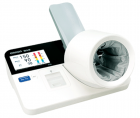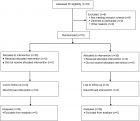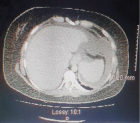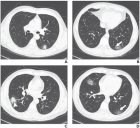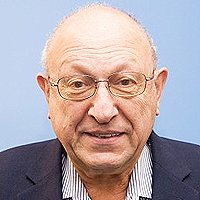Abstract
Research Article
Defibrillation of Atrial Fibrillation is not Associated with Increased Risk of Ventricular Fibrillation – The VCD-Trial (Clinical Trial of Electrical Therapy for Atrial Fibrillation using R-wave Guided Cardioversion Versus Defibrillation)
Christian Keller*, Martina Gercken, Jens Hagemeister, Martin Hellmich, Uta Hoppe and Damian Franzen
Published: 19 August, 2024 | Volume 9 - Issue 2 | Pages: 120-125
Background: Because of a possible risk of induction of Ventricular Fibrillation (VF) by defibrillation of atrial fibrillation (AF) postulated by LOWN and coworkers, synchronized cardioversion is used worldwide. This prospective, randomized study assessed the efficacy and safety between R-wave controlled cardioversion and defibrillation of AF at 2 study centers in Cologne, Germany.
Hypothesis: Defibrillation is not significantly different from cardioversion primarily in the occurrence of VF or sustained Ventricular Tachycardia (VT) and secondarily in restoring sinus rhythm, inducing non-sustained VT, asystole, or bradycardia.
Methods: 146 patients at an outpatient practice and 122 at the university hospital were randomized to cardioversion (n = 140) or defibrillation
(n = 124).
Results: Cardioversion was successful in 92.1% of cases and defibrillation in 87.1%. The difference in efficacy was not statistically significant. In n = 1 patients receiving defibrillation, VF occurred after the first shock (200J) and immediate defibrillation (200J) restored sinus rhythm. In the n = 1 case, asystole occurred during cardioversion which terminated spontaneously. In n = 1 patients cardioverted and n = 2 who were defibrillated, sinus bradycardia occurred requiring Atropine in two cases. There were no thromboembolic events within 10 days. N = 9 patients reverted to AF within two hours. No patients died.
Conclusion: Electrical conversion of AF can be performed with similar results and low risk with both R-wave-triggered cardioversion and defibrillation. In particular, defibrillation with higher energies (> 100J) can be performed as effectively and safely without a statistically significant increased risk of VF or VT. There was no difference in efficacy and risk between electrotherapy performed in the outpatient and inpatient settings.
Read Full Article HTML DOI: 10.29328/journal.jccm.1001191 Cite this Article Read Full Article PDF
References
- Wyse DG, Waldo AL, DiMarco JP, Domanski MJ, Rosenberg Y, Schron EB, et al. A comparison of rate control and rhythm control in patients with atrial fibrillation. N Engl J Med. 2002;347:1825-1833. Available from: https://doi.org/10.1056/nejmoa021328
- Fuster V, Ryden LE, Cannom DS, Crijns HJ, Curtis AB, Ellenbogen KA, et al. ACC/AHA/ESC 2006 guidelines for the management of patients with atrial fibrillation-executive summary: a report of the American College of Cardiology/American Heart Association Task Force on practice guidelines and the European Society of Cardiology Committee for Practice Guidelines (Writing Committee to Revise the 2001 Guidelines for the Management of Patients with Atrial Fibrillation). Eur Heart J. 2006;27:1979-2030. Available from: https://doi.org/10.1161/circulationaha.106.177292
- Lown B, Amarasingham R, Neuman J. New method for terminating cardiac arrhythmias. Use of synchronized capacitor discharge. JAMA. 1962;182:548-555. Available from: https://pubmed.ncbi.nlm.nih.gov/13931298/
- King B. The effect of electric shocks on heart action with special reference to varying susceptibility in different parts of the cardiac cycle. New York, N.Y.: Columbia University; 1934. PhD dissertation. Available from: https://doi.org/10.3181/00379727-31-7355P
- Kavanagh-Gray D. Non-synchronized direct-current countershock in cardiac arrhythmias. Can Med Assoc J. 1967;96(22):1460-1462. Available from: https://pubmed.ncbi.nlm.nih.gov/6025722/
- Waris EK, Scheinin TM, Kreus KE, Salokannel J, Scheinin BM. Non-synchronized direct current countershock. Acta Med Scand. 1965;178:309-320.
- Ross EM. Cardioversion causing ventricular fibrillation. Arch Intern Med. 1964;114:811-814. Available from: https://doi.org/10.1001/archinte.1964.03860120123015
- Birgersdotter-Green U, Undesser K, Fujimura O, Feld GK, Kass RM, Mandel WJ, et al. Correlation of acute and chronic defibrillation threshold with upper limit of vulnerability determined in normal sinus rhythm. J Interv Card Electrophysiol. 1999;3:155-161. Available from: https://doi.org/10.1023/a:1009825731592
- Collins LJ, Silverman DI, Douglas PS, Manning WJ. Cardioversion of nonrheumatic atrial fibrillation. Reduced thromboembolic complications with 4 weeks of precardioversion anticoagulation are related to atrial thrombus resolution. Circulation. 1995;92(2):160-163. Available from: https://doi.org/10.1161/01.cir.92.2.160
- Hindricks G, Potpara T, Dagres N, Arbelo E, Bax JJ, Blomström-Lundqvist C, et al. 2020 ESC Guidelines for the diagnosis and management of atrial fibrillation developed in collaboration with the European Association of Cardio-Thoracic Surgery (EACTS). Eur Heart J. 2021;42(5):373-498. Available from: https://doi.org/10.1093/eurheartj/ehaa612
- Kirchhof P, Eckardt L, Loh P, Weber K, Fischer RJ, Seidl KH, et al. Anterior-posterior versus anterior-lateral electrode positions for external cardioversion of atrial fibrillation: a randomised trial. Lancet. 2002;360(9342):1275-1279. Available from: https://doi.org/10.1016/s0140-6736(02)11315-8
- Herregods LL, Bossuyt GP, De Baerdemaeker LE, Moerman AT, Struys MM, Den Blauwen NM, et al. Ambulatory electrical external cardioversion with propofol or etomidate. J Clin Anesth. 2003;15(2):91-96. Available from: https://doi.org/10.1016/s0952-8180(02)00520-2
- Franzen D, Brombach K, Möbius H. Ambulatory electrical cardioversion of atrial fibrillation. Int J Cardiol. 2006;107(3):303-306. Available from: https://doi.org/10.1016/j.ijcard.2005.03.043
- Hou CJ, Zheng ZJ, Wu J, et al. Determination of ventricular vulnerable period and ventricular fibrillation threshold by use of T-wave shocks in patients undergoing implantation of cardioverter/defibrillators. Circulation. 1995;92(9):2558-2564. Available from: https://pubmed.ncbi.nlm.nih.gov/7586357/
Figures:
Similar Articles
-
Left Atrial Remodeling is Associated with Left Ventricular Remodeling in Patients with Reperfused Acute Myocardial InfarctionChristodoulos E. Papadopoulos*,Dimitrios G. Zioutas,Panagiotis Charalambidis,Aristi Boulbou,Konstantinos Triantafyllou,Konstantinos Baltoumas,Haralambos I. Karvounis,Vassilios Vassilikos. Left Atrial Remodeling is Associated with Left Ventricular Remodeling in Patients with Reperfused Acute Myocardial Infarction. . 2016 doi: 10.29328/journal.jccm.1001001; 1: 001-008
-
Mid-Ventricular Ballooning in Atherosclerotic and Non-Atherosclerotic Abnormalities of the Left Anterior Descending Coronary ArteryStefan Peters*. Mid-Ventricular Ballooning in Atherosclerotic and Non-Atherosclerotic Abnormalities of the Left Anterior Descending Coronary Artery. . 2016 doi: 10.29328/journal.jccm.1001002; 1:
-
Concentration Polarization of Ox-LDL and Its Effect on Cell Proliferation and Apoptosis in Human Endothelial CellsShijie Liu*,Jawahar L Mehta,Yubo Fan,Xiaoyan Deng,Zufeng Ding*. Concentration Polarization of Ox-LDL and Its Effect on Cell Proliferation and Apoptosis in Human Endothelial Cells. . 2016 doi: 10.29328/journal.jccm.1001003; 1:
-
Intermittent Left Bundle Branch Block: What is the Mechanism?Hussam Ali*,Riccardo Cappato. Intermittent Left Bundle Branch Block: What is the Mechanism?. . 2017 doi: 10.29328/journal.jccm.1001004; 2:
-
Congenital Quadricuspid Aortic Valve, a Rare Cause of Aortic Insufficiency in Adults: Case ReportCyrus Kocherla*,Kalgi Modi. Congenital Quadricuspid Aortic Valve, a Rare Cause of Aortic Insufficiency in Adults: Case Report. . 2017 doi: 10.29328/journal.jccm.1001005; 2: 003-007
-
Short and Medium-Term Evaluation of Patients in Coronary Post-Angioplasty: Préliminary results at the Cardiology Department of the Hospital University Aristide Le Dantec of Dakar (Senegal): Study on 38 CasesDioum M*,Aw F,Masmoudi K,Gaye ND,Sarr SA,Ndao SCT, Mingou J,Ngaidé AA,Diack B,Bodian M,Ndiaye MB,Diao M,Ba SA. Short and Medium-Term Evaluation of Patients in Coronary Post-Angioplasty: Préliminary results at the Cardiology Department of the Hospital University Aristide Le Dantec of Dakar (Senegal): Study on 38 Cases. . 2017 doi: 10.29328/journal.jccm.1001006; 2: 008-012
-
Indications and Results of Coronarography in Senegalese Diabetic Patients: About 45 CasesNdao SCT*,Gaye ND,Dioum M,Ngaide AA,Mingou JS,Ndiaye MB, Diao M,Ba SA. Indications and Results of Coronarography in Senegalese Diabetic Patients: About 45 Cases. . 2017 doi: 10.29328/journal.jccm.1001007; 2: 013-019
-
Procedure utilization, latency and mortality: Weekend versus Weekday admission for Myocardial InfarctionNader Makki,David M Kline,Arun Kanmanthareddy,Hansie Mathelier,Satya Shreenivas,Scott M Lilly*. Procedure utilization, latency and mortality: Weekend versus Weekday admission for Myocardial Infarction. . 2017 doi: 10.29328/journal.jccm.1001008; 2: 020-025
-
Spontaneous rupture of a giant Coronary Artery Aneurysm after acute Myocardial InfarctionOğuzhan Çelik,Mucahit Yetim,Tolga Doğan,Lütfü Bekar,Macit Kalçık*,Yusuf Karavelioğlu. Spontaneous rupture of a giant Coronary Artery Aneurysm after acute Myocardial Infarction. . 2017 doi: 10.29328/journal.jccm.1001009; 2: 026-028
-
Thrombolysis, the only Optimally Rapid Reperfusion TreatmentVictor Gurewich*. Thrombolysis, the only Optimally Rapid Reperfusion Treatment. . 2017 doi: 10.29328/journal.jccm.1001010; 2: 029-034
Recently Viewed
-
Trends in TeledentistryRudrakshi C*. Trends in Teledentistry. J Clin Adv Dent. 2020: doi: 10.29328/journal.jcad.1001014; 4: 004-005
-
Au26-35: A Special Geometrical Structure of Au33 (D2) Cluster with Highly Occupied - 14 Pairs of Double-State DegeneracyK Vishwanathan*. Au26-35: A Special Geometrical Structure of Au33 (D2) Cluster with Highly Occupied - 14 Pairs of Double-State Degeneracy. Ann Adv Chem. 2022: doi: 10.29328/journal.aac.1001035; 6: 063-080
-
Texture of Thin Films of Aluminum Nitride Produced by Magnetron SputteringStrunin Vladimir Ivanovich,Baranova Larisa Vasilievna*,Baisova Bibigul Tulegenovna. Texture of Thin Films of Aluminum Nitride Produced by Magnetron Sputtering. Int J Phys Res Appl. 2025: doi: 10.29328/journal.ijpra.1001106; 8: 013-016
-
Minimising Carbon Footprint in Anaesthesia PracticeNisha Gandhi and Abinav Sarvesh SPS*. Minimising Carbon Footprint in Anaesthesia Practice. Int J Clin Anesth Res. 2024: doi: 10.29328/journal.ijcar.1001025; 8: 005-007
-
On Friedman equation, quadratic laws and the geometry of our universeS Kalimuthu*. On Friedman equation, quadratic laws and the geometry of our universe. Int J Phys Res Appl. 2021: doi: 10.29328/journal.ijpra.1001041; 4: 048-050
Most Viewed
-
Evaluation of Biostimulants Based on Recovered Protein Hydrolysates from Animal By-products as Plant Growth EnhancersH Pérez-Aguilar*, M Lacruz-Asaro, F Arán-Ais. Evaluation of Biostimulants Based on Recovered Protein Hydrolysates from Animal By-products as Plant Growth Enhancers. J Plant Sci Phytopathol. 2023 doi: 10.29328/journal.jpsp.1001104; 7: 042-047
-
Sinonasal Myxoma Extending into the Orbit in a 4-Year Old: A Case PresentationJulian A Purrinos*, Ramzi Younis. Sinonasal Myxoma Extending into the Orbit in a 4-Year Old: A Case Presentation. Arch Case Rep. 2024 doi: 10.29328/journal.acr.1001099; 8: 075-077
-
Feasibility study of magnetic sensing for detecting single-neuron action potentialsDenis Tonini,Kai Wu,Renata Saha,Jian-Ping Wang*. Feasibility study of magnetic sensing for detecting single-neuron action potentials. Ann Biomed Sci Eng. 2022 doi: 10.29328/journal.abse.1001018; 6: 019-029
-
Pediatric Dysgerminoma: Unveiling a Rare Ovarian TumorFaten Limaiem*, Khalil Saffar, Ahmed Halouani. Pediatric Dysgerminoma: Unveiling a Rare Ovarian Tumor. Arch Case Rep. 2024 doi: 10.29328/journal.acr.1001087; 8: 010-013
-
Physical activity can change the physiological and psychological circumstances during COVID-19 pandemic: A narrative reviewKhashayar Maroufi*. Physical activity can change the physiological and psychological circumstances during COVID-19 pandemic: A narrative review. J Sports Med Ther. 2021 doi: 10.29328/journal.jsmt.1001051; 6: 001-007

HSPI: We're glad you're here. Please click "create a new Query" if you are a new visitor to our website and need further information from us.
If you are already a member of our network and need to keep track of any developments regarding a question you have already submitted, click "take me to my Query."






